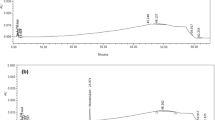Abstract
A simple, accurate, selective, precise, economical and stability-indicating high-performance thin-layer chromatographic method for analysis of forskolin in crude drug and in pharmaceutical dosage form was developed and validated. The method was developed on TLC aluminium plates precoated with silica gel 60F-254 using solvent system benzene:methanol (9:1, v/v), which gives compact spot of forskolin (R f value 0.25 ± 0.02). Densitometric analysis of forskolin was carried out in the absorbance mode at 545 nm after spraying with anisaldehyde sulphuric acid. The linear regression analysis data for the calibration plots showed good linear relationship with r = 0.994 and 0.994 with respect to peak height and peak area, respectively, in the concentration range 100–1,000 ng per spot. The limits of detection and quantification were 8.1 and 26.9 ng per spot, respectively. The proposed method was applied for determination of forskolin in Coleus forskohlii root and in capsule dosage forms, which showed 0.18 and 0.57% w/w of forskolin. Forskolin was subjected to acid and alkali hydrolysis, oxidation, photodegradation and heat degradation. It was observed that the drug is susceptible to acid, base hydrolysis, oxidation, photo-oxidation and heat degradation. Statistical analysis proves that the method is repeatable, selective and accurate for the estimation of forskolin in crude drug and in pharmaceutical dosage forms. The developed method effectively resolved the forskolin from components of C. forskohlii root, from excipients of capsule as well as the degradation products of forskolin hence, it can be employed for routine analysis and as a stability-indicating method.




Similar content being viewed by others
References
Bhat SV, Bajwa BS, Dornauer H, De Souza NJ, Fehlhaber HW (1977) Tetrahedron Lett 19:1669–1672
Tandon JS, Dhar MM, Ramakumar S, Venkatesan K (1977) Indian J Chem 15B:880–883
Dubey MP, Srimal RC, Nityanand S, Dhawan BN (1981) J Ethnopharmacol 3:1–13
Seamon KB, Daly JW (1981) J Cyclic Nucleotide Res 7:201–224
Wysham DG, Brotherton AF, Heistad DD (1986) Stroke 17:1299–1303
Marone G, Columbo M, Triggiani M (1986) Agents Actions 18:96–99
Roger PP, Servais P, Dumont JE (1990) Exp Cell Res 172:282–292
Allen DO, Ahmed B, Naseer K (1986) J Pharmacol Exp Ther 238:659–664
Lichey I, Friedrich T, Priesnitz M, Biamino G, Usinger P, Huckauf H (1984) Lancet 2:167
Caprioli J, Sears M (1983) Lancet 1:958–960
Dubey MP, Srimal RC, Nityanand S, Dhawan BN (1981) J Ethnopharmacol 3:1–13
Agarwal KC, Parks RE (1983) Int J Cancer 32:801–804
Ammon HP, Muller AB (1984) Naunyn Schmiedebergs Arch Pharmacol 326:364–367
Wong S, Mok W, Phaneuf S, Katz S, Salari H (1993) Eur J Pharmacol 245:55–61
Ding X, Staudinger JL (2005) J Pharmacol Exp Ther 312:849–856
Yanagihara H, Sakata R, Shoyama Y, Murakami H (1996) Planta Med 62:169–172
Schaneberg BT, Khan IA (2003) J AOAC Int 86:467–470
Bonté F, Pinguet P, Saunois A, Chevalier JM, Meybeck A (1997) J Chromatogr A 791:231–235
Wagner H, Bladt S (1996) Plant drug Analysis: A thin layer chromatography atlas. Springer, New York, p 359
ICH (1994) Text on Validation of Analytical Procedures, Harmonised Tripartite Guideline prepared within the International Conference on Harmonisation of Technical Requirements for the Registration of Pharmaceuticals for Human Use, ICH-Q2A, Geneva
ICH (1996) Validation of Analytical Procedures: Methadology, Harmonised Tripartite Guideline prepared within the International Conference on Harmonisation of Technical Requirements for the Registration of Pharmaceuticals for Human Use, ICH-Q2B, Geneva
ICH (1995) Draft guidelines on validation of analytical procedures: definition and terminology, federal register, vol 60. IFPMA, Switzerland
ICH (2003) Stability testing of new drug substances and products (Q1AR2). In: Proceedings of the international conference on harmonization, IFPMA, Geneva
Vishwakarma RA, Tyagi BR, Ahmed B, Hussain M (1988) Planta Med 54:471–472
Saleem AM, Dhasan PB, Rafiullah MRM (2006) J Chromatogr A 1101:313–314
Acknowledgments
The authors are thankful to Sami Labs Ltd., Bangalore for providing standard forskolin as a gift sample.
Author information
Authors and Affiliations
Corresponding author
Rights and permissions
About this article
Cite this article
Ahmad, S., Rizwan, M., Parveen, R. et al. A Validated Stability-Indicating TLC Method for Determination of Forskolin in Crude Drug and Pharmaceutical Dosage Form. Chroma 67, 441–447 (2008). https://doi.org/10.1365/s10337-008-0521-x
Received:
Revised:
Accepted:
Published:
Issue Date:
DOI: https://doi.org/10.1365/s10337-008-0521-x




